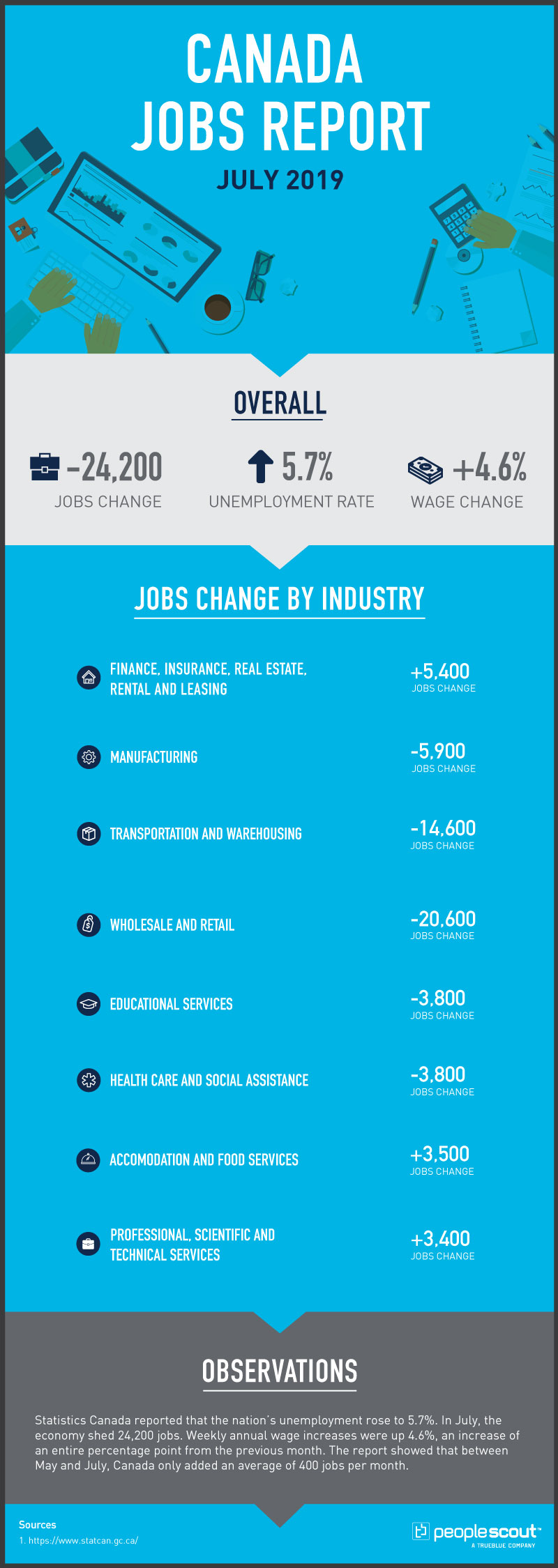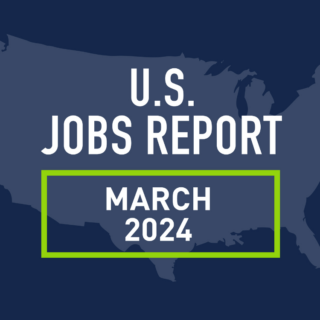Statistics Canada reported that the nation’s unemployment rose to 5.7%. In July, the economy shed 24,200 jobs. Weekly annual wage increases were up 4.6%, an increase of an entire percentage point from the previous month. The report showed that between May and July, Canada only added an average of 400 jobs per month.

The Numbers
-24,200: The economy lost 24,200 jobs in July.
5.7%: The unemployment rate rose to 5.7%.
4.6%: Weekly wages increased 4.6% over the last year.
The Good
Statistics Canada reported that compared with July 2018, employment increased by 353,000 employed Canadians or 1.9%. The annual increase was fueled by gains in full-time work which increased by 326,000 or 2.2%. Annual wage gains jumped to 4.6% at the weekly level from 3.6% in June. Annual hourly wages increased by 4.5%, the highest level since January 2009.
After two months of negligible changes in the labour market in Quebec, employment rose by 17,000 in July, with healthy increases in manufacturing and construction. The unemployment rate was unchanged at 4.9% because more Quebecers entered into the labour force. Year over year, employment in Quebec increased by 96,000 or +2.3%.
For the nation as a whole, construction jobs grew by 25,000 in July. About 9,200 more Canadians were working in public administration than in June, primarily due to increases in Ontario.
The Bad
The Canadian economy shed jobs for the second month in a row. In the May-July quarter, Canada only added an average of 400 jobs per month. There were job losses in Alberta, Nova Scotia and New Brunswick. After two months of increases, jobs fell in transportation and warehousing by 15,000. The number of private-sector employees decreased by 69,000 in July, primarily from losses in the wholesale and retail trade.
Some analysts pointed to the weak July job numbers as evidence that the Canadian labour markets is beginning to weaken. Brendon Bernard of Indeed Canada noted:
“While still in decent shape overall, the job market clearly has lost some momentum. It’s discouraging to see employment growth lose steam amid recent signs of turmoil in the global economy.”
The Unknown
There has been a significant shift in the age demographics of the Canadian workforce in recent years. HRD Canada reports that there are roughly the same number of Canadian workers who are aged 25 to 34 as there are 55 and older. in 1996, older workers made up just 10% of the workforce. But by 2018, this percentage more than doubled to 21%.
Statistics Canada reports that while the proportion of older workers has increased throughout the Canadian economy, the shift in the healthcare sector is particularly notable:
“Healthcare and social assistance was the largest industry in Canada in 2016, accounting for 2.3 million or 13%, of all workers. This industry also had one of the most rapid growth rates in the number of workers from 1996 to 2016 (+68%).
Despite the rising demand for health care services, workers who are providing health care to an increasingly older population are themselves aging. For instance, among registered nurses and registered psychiatric nurses—the largest occupation related to health care—about 1 in 5 was aged 55 and older in 2016, compared with less than 1 in 10 in 1996.
In 1996, there were 4.5 female nurses aged 25 to 34 for each female nurse aged 55 and older. By 2016, that ratio had declined to 1.6.
Similarly, specialist physicians had one of the largest shares of older workers at 31% in 2016, compared with 23% in 1996.”
While Canadian employers may have to plan for more than 20% of their workforce reaching retirement age in the next ten years, they will most likely avoid the challenge of workers retiring early. Benefits Canada reports that an increasing number of Canadians aged 60 and over are staying in the workforce with 90% of those in this age group working in some capacity.
Canadian employers face the challenge of leveraging the experience and skills of their older workers while putting effective succession plans in place to prepare for the high levels of retirement to come. An important part of succession planning is a recruitment strategy that onboards new talent in time to receive training and mentorship from older workers who have contributed to the success of an enterprise. The expertise provided by a recruitment process outsourcing company can help organizations institute talent acquisition programs that take succession planning into account while providing solutions for immediate hiring needs.

